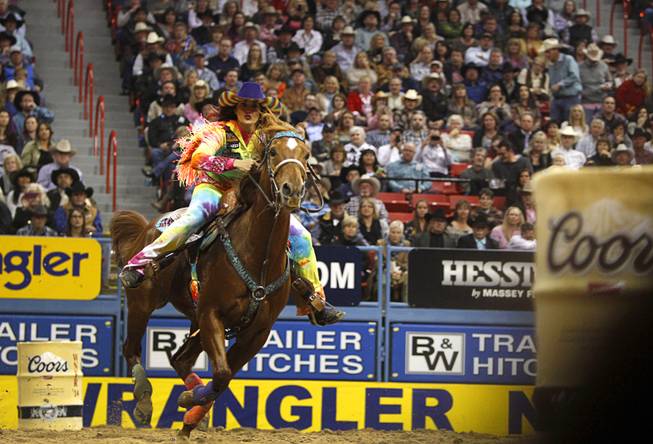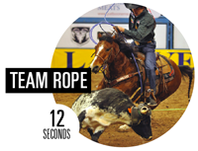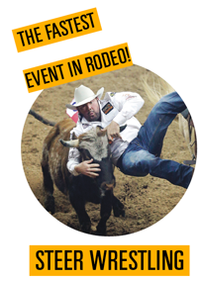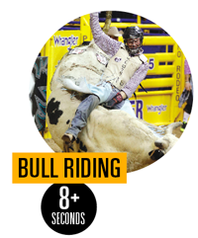
Fallon Taylor of Whitesboro, Texas, competes during the first go-round of the Wrangler National Finals Rodeo in Las Vegas on Thursday, Dec. 4, 2014. Taylor’s time was the best of the night at 14.09 seconds.
Sunday, Dec. 7, 2014 | 2 a.m.
For many Las Vegans, much of what happens inside the Thomas and Mack Center during the Wrangler National Finals Rodeo is a mystery.
A lot of us are city slickers, after all. The closest we get to horses and cattle is a petting zoo, so most of us know very little about rodeo.
Not anymore. Here’s a look at what the cowboys and cowgirls in town are up to and the skills they must master to bring home their share of a multimillion-dollar purse.
Team Rope
Objective: Capture and pin down a steer as fast as possible | Scoring: Timed, penalties for starting early or not roping both legs
The only team event in rodeo and the only event in which women can compete with men, team roping involves amazing coordination and cooperation. The goal is to capture and pin down a steer.

Two mounted riders work in tandem in the timed event. The header ropes the front part of the steer, the heeler ropes the animal’s hind feet.
The only team event in rodeo and the only event in which women can compete with men, team roping involves amazing coordination and cooperation. The goal is to capture and pin down a steer.
Two mounted riders work in tandem in the timed event. The header ropes the front part of the steer, the heeler ropes the animal’s hind feet.
The riders start in a box set behind a rope, and the steer is given a head start. A 10-second penalty is given if either rider crosses the rope prematurely. The header leaves the box first and uses his rope to catch the horns, head or neck of the steer.
Once the header completes his task and turns the animal, the heeler can rope its hind legs. If the heeler catches only a single leg, a 5-second penalty is added to the team’s score.
When both ropers have looped the steer, each must back up his horse to stretch and immobilize the animal. Time is stopped once the steer is immobilized. Most professional team ropers log times of 12 seconds or less.
Bareback Bronc
Objective: Stay on horse for 8 seconds | Rules: Can hold on with only one hand | Scoring: Total of 100 points | Rider’s technique and control: 50 points | Horse’s power, speed and agility: 50 points

Bareback bronc riding is the most explosive and physically demanding rodeo event.
Riding a horse without a saddle requires skill, balance and coordination as there’s no equipment to compensate for errors. It can be dangerous, but enthusiasts say it’s the most natural way to ride. It’s also an intense workout, strengthening the rider’s legs and core.
Competitors climb onto a horse held in a small wooden enclosure called a bucking chute. When the rider is ready, the gate is opened, and the horse bursts out, bucking. The rider must try to stay on the horse for eight seconds, holding with only one hand a small leather device that resembles a suitcase handle strapped to the horse. He cannot touch the horse with the other hand or he is disqualified.
On the first jump out of the chute, the rider must have both spurs touching the horse’s shoulders until the horse’s feet hit the ground, a move called “marking out.” If the cowboy fails to do that, he is disqualified.
As the bronc bucks, the rider must pull up his knees and roll his spurs up the horse’s shoulders. As the horse descends, he must straighten his legs. The rider’s body should be square and his free arm controlled.
Riders are scored 0 to 50 for their control and spurring technique. The horse is scored 0 to 50 for power, speed and agility. Wilder horses score higher than ones that buck in a straight line with no significant change in direction.
Steer Wrestling
Objective: Take down the steer as fast as possible | Rules: Can hold on with only one hand | Scoring: Timed, penalties for starting early

Steer wrestling, also known as bulldogging, is the fastest event in rodeo; on average, it lasts only a few seconds.
The wrestler begins on horseback in a roped-off starting box. The steer gets a head start, then the cowboy can take off. Crossing the rope early results in a 10-second penalty. When the cowboy reaches the steer, he slides down off the right side of his galloping horse, hooks his right arm around the steer’s right horn, grasps the left horn with his left hand, plants his feet on the ground, and using strength and leverage, slows the animal and wrestles it to the ground. The clock stops when all of the animal’s legs are off the ground.
A second mounted cowboy, called a hazer, gallops along the right side of the steer to keep it running in a straight line and prevent it from veering away from the bulldogger. Typical professional rounds last 3 to 10 seconds. Steers generally weigh about 600 pounds, and when riders collide with them, both can be traveling as fast as 30 mph.
Bull Riding
Objective: Stay on bull for at least 8 seconds | Rules: Rider can hold on to a rope with only one hand | Scoring: Both bull and rider are judged for a total of 50 points. Bulls are given scores regardless of whether the rider falls off.
Bull riding is among the most recognizable rodeo events and arguably the most dangerous. Most cowboys say it isn’t a matter of if you get hurt bull riding, but when.

The cowboy grips a flat, braided rope with one hand and is disqualified if his other hand touches the bull. Typically, bulls and riders are matched randomly.
The bull bucks, rears, kicks, spins and twists to try to throw the rider off. The round ends when the rider gets bucked off or dismounts. A loud buzzer or whistle announces the completion of an eight-second ride.
Rodeo clowns stand nearby to help the rider if needed. When the ride ends, either intentionally or not, the clowns, also known as bullfighters, distract the bull to protect the rider from harm.
Two judges each give 0 to 25 points for the cowboy’s performance and 0 to 25 points for the animal’s performance. A score of 100 is considered a perfect ride. In humans, judges look for control, rhythm, balance, style, spurring and a rider who matches a bull’s movements. To receive points, the cowboy must stay mounted for the full eight seconds. In the bull, judges look for agility, power and speed; multiple direction changes; back-end kicks; and front-end drops. Bulls who give riders a hard time typically score more points. Bulls are awarded scores regardless of whether the rider falls off; the animals are considered athletes, too.
Barrel Racing
Objective: Maneuver an obstacle course as fast as possible. | Scoring: Timed, penalties for knocking down barrels.

In barrel racing, primarily an event for women, speed is paramount. Cowgirls must use their horsemanship skills and harness their horse’s athletic ability to maneuver a cloverleaf pattern around three barrels placed in a triangle in the center of an arena.
Riders take off galloping and steer their horses as close as they can around 55-gallon metal or plastic drums to shave seconds off the clock. A knocked-down barrel nets a 5-second penalty. Riders can choose to start at either the left or right barrel but must turn a complete circle around the first barrel before continuing. She circles the second barrel, then the third, then races to the finish line.
Most riders enter the arena at a full run, reaching maximum speed before they hit the timer. The clock stops as soon as the horse’s nose crosses the finish line. Races typically last 13 to 14 seconds.

Join the Discussion:
Check this out for a full explanation of our conversion to the LiveFyre commenting system and instructions on how to sign up for an account.
Full comments policy